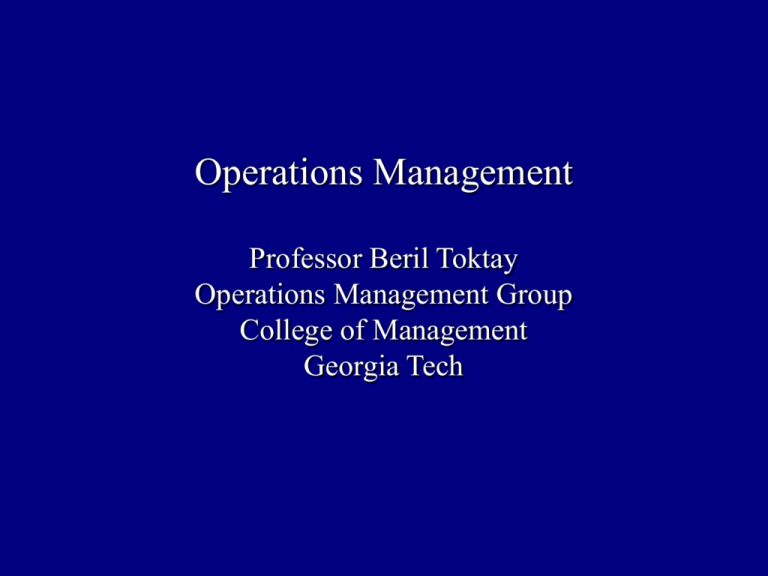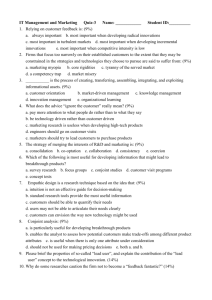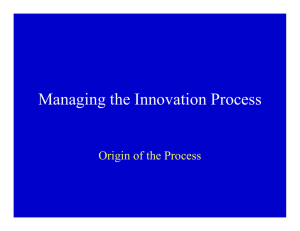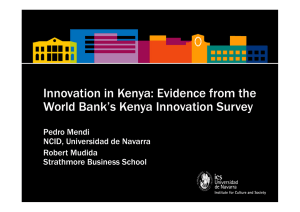Introduction to OM_Spring06
advertisement

Operations Management Professor Beril Toktay Operations Management Group College of Management Georgia Tech Who Am I? • BS in Industrial Engineering & Math from Bosphorus University • MS in Industrial Engineering from Purdue University • PhD in Operations Research from MIT • Taught at INSEAD until last year What Will We Do Today? • How is this course organized? • Why Operations Management? The First Industrial Revolution (c. 1850) • Textile manufacturing innovations “Flying shuttle” and “Spinning Jenny” • J. Watt: The steam engine Substituting labor with machines small scale production • A. Smith: Free markets – division of labor Free markets would enhance “quest” for profit Specialization could increase productivity The American System of Manufacturing • Vertical Integration Consolidating different operations under one roof • Interchangeable parts Mass-produce parts to tight tolerance & assemble 1801 contract for 10,000 muskets for the government • Unskilled workers The Second Industrial Revolution (c. 1910) • 1832: 36 enterprises in 10 states with > 250 workers Reliance on water power & local distribution system • Transportation innovations Railroads are built in western world large scale production • Communication innovations The telegraph is established • Big retailers come to power Sears & Roebuck’s sales soar to $38M in 10 years • Mass Production: the first vehicles arrive… Henry Ford starts producing Model T 1910-1920: The Scientific Method (Taylorism) • Principles of Scientific Management Book published in 1911 by Fredrick Taylor • Time and Motion studies How much time do workers need to do a task? • Incentive systems What is the best payment scheme? Efficiency is the key! • Study how systems can be efficient Developed a set of principles that serve efficiency. Planning versus doing. 1920’s - 1930’s: Taylorism Spreads • Application of Taylor’s methods The DuPont Powder company • More importance to the human element Studies at the Western Electric Hawthorne plant to understand ergonomics: the human element in manufacturing • Investment in management education Between 1914 and 1940 B-schools grew a lot 1940’s - 1960’s: The Golden Era in the U.S. • Operations Research tools are “born” G.B. Dantzig devises simplex algorithm • Effort to study complex systems The importance of teamwork is introduced • Mathematical analysis becomes the norm Scientific methods are applied throughout the organization • Mathematics solidify the scientific method Simulation based models, computer usage, scheduling 1970’s: Computers and MRP take over Production Schedule Bill of materials Inventory status Forecasted Demand MRP (Materials Requirement Planning) MRP automated production… But, someone has to tell the computers what to analyze! 1980’s: The Japanese Challenge American manufacturing led until the late 70’s, but then… TQC: Total Quality Control Higher quality Less cost JIT: Just-In-Time The methods introduced by Japanese manufacturing firms outperformed the US … 1990’s: The U.S. rises to the challenge Entrepreneurship and the ability to change and re-invent themselves allowed American firms to move into new areas. • U.S. firms improve productivity and quality. • U.S. firms focus on emerging technologies, R&D. • Growth of the service industry. • Examples in OM…. Why Operations Management? Operations Management = Strategy Execution Time Quality Flexibility Cost OM = Designing, operating, and improving the systems that deliver the firm’s primary products and services Strategy Execution 1. What is our strategy? 2. How do we design our operations to support it? Product / Service Development Process Design and Management Supply Chain Management Strategy Execution What’s their strategy? How do they execute it? Dell Southwest Walmart Toyota Amazon Organization of Course • Class web site (can link from Webct) http://www.prism.gatech.edu/~bt71/mgt3501/course-page.htm • Recommended text: Operations Management for Competitive Advantage, 11th Edn, by Chase, Jacobs, and Aquilano. • Grading: 2 Midterms (20% each), Final (40%), 2 mini-case write-ups (20%). Participation can bump you up if borderline. • 4-5 person groups for write-ups: Form by Jan 24. • Attendance: Voluntary • Homework: For your own practice. • On-time arrival to class: grade cutoff will drop by 0.04 for each time that at most 2 people are late to class. • Office hours, T/Th 11-12: Use them!!











